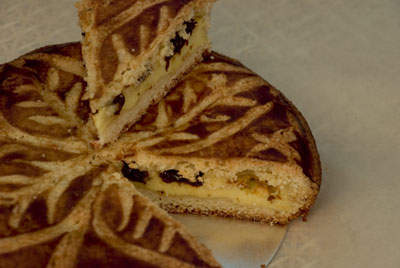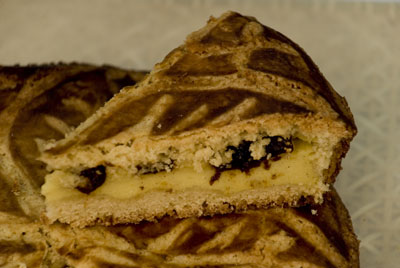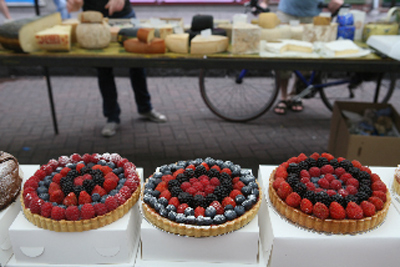Children’s birthday cake ~ banana cake trains!
I baked this set of trains for my kid’s best friend’s 4th birthday!
I kept the icing simple with just three colours & as minimal as I can allow it. I stayed away from using sugary gum drops & other store-bought sweets because: One, as a parent I wouldn’t want my 4 year old introduced to those things yet, & Two, icing them is so much cheaper! :)
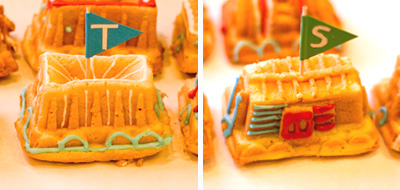
Handmade paper flags glued to cocktail sticks:
I decided it’s better if the flags were not white. It will be lost in the background, & the coloured flags would add the much needed extra colourfulness that my minimal-icing-ideology doesn’t provide. – But on the other hand, I made more work for myself & D (he helped), as I couldn’t just ‘stamp’ letters on to dark coloured paper (I don’t have white ink), & had to cut each letter out & glue them!
Each child received one train each. It was easily distributed since there was no cutting slices involved. The flags were popular (“I’ve got K!” & so on). Everyone took it home with them!
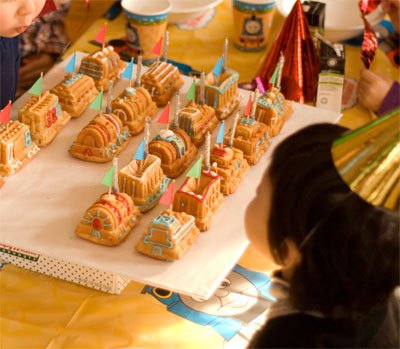
(At every children’s birthday party we go to, there’ll always be another kid who’d be blowing the candles too! :)

(For the cake board base: I cut cardboard to size & covered it with white baking paper.)
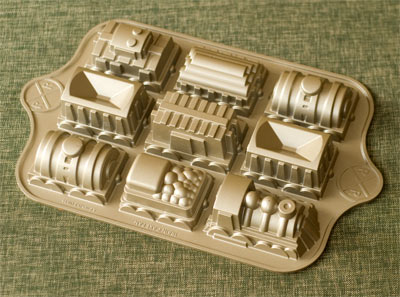
(Nordicware Train Cake Pan purchased from Lakeland)
.
Am I turning in to a right old woman or what?
Because when D spotted the Nordicware Train Cake Pan in the shop, I was soooo happy – like, deliriously, over the moon style! It’s really difficult to find Nordicware here in the UK, & this particular train cake pan had been on my wish-list for over a year. I once spent a whole night trawling the internet to see if anyone sells this in this country but to no avail…
BUT…! Out-of-the-blue, there it was in front of my eyes… SO, readers, hopefully you can understand my cake-fanaticism, & picture me enthusiastically charging my way to the cash-till in nano-second-flat, flared nostrils, seeing nothing but red until I successfully purchased it, until “It-Is-Mine!” (followed by manic laughter – Dr Evil style…)
.
x x x x x x x x x x x x x x x x x x x x x x x x x x x x x x x x x x x
.
This purchase came at the perfect timing too, as the following week I was to make a birthday cake for my son’s best friend. Like always, I test-baked several days before the real bake-day, to remove any uncertainties that could potentially ruin the result. The lessons learnt from the test-bake was valuable:
- The cake batter must be piped (not dolloped in), so that the batter reaches all intricate detail of this cake pan.
- Batter must be pasted/ pushed to all the sides with a spatula to avoid ugly air-holes appearing on the train surfaces.
- Batter must be to the fullest brim to perfectly imprint the cake design.
- Must use more colours than just white for the icing, unless it’s a snowy scene you’re trying to create.
- It is best to pipe extra details like ‘grills’ & ‘windows’ or even abstract polka-dots, rather than faithfully outlining/ following the grooves of the cake.
- Mustn’t pipe too much icing on it because the cake would become too sweet – & I can imagine the parents getting worried about too much sugar consumption! (especially if it’s artificially coloured!)
.
After consideration, I decided it should be a banana cake. A boring sponge won’t do (it’ll taste too normal unless there’s a delicious filling layer), nor it shouldn’t be chocolate coloured (the imprinted design wouldn’t be as visible). D suggested ‘marbled cake’ but that’ll just be ‘too busy’ with the intricate designs. – But a banana cake on the other-hand I thought, is gorgeously moist, popular with everyone & should get a nod of approval from the parents as it sounds natural & it uses less refined sugar.
.
So here is the recipe for my banana cake. It is a ‘Pâte à biscuit’ sponge method. (whereby the egg is separated – yolk goes in with the sugar, & the whites are whisked to a meringue, before being combined.)
I also added the recipe for the royal icing at the end.
Both recipes are easy-peasy to make!
.
x x x x x x x x x x x x x x x x x x x x x x x x x x x x x x x x x x x
.
MOIST BANANA CAKE RECIPE:
.
Ingredients:
(quantities to fill the Nordicware train pan)
200g Ripe bananas
100g Sugar
5 x Egg yolk
5 x Egg whites
100g Sugar (to whisk in to the whites)
150g Plain flour
75g Almond powder
75g Butter
.
Prepare in advance the following:
- Butter the mould (here, it is best to use a pastry brush & slightly melted butter to really get to every intricate details & grooves). And finely flour the mould by sifting it.
- Melt 75g of butter. Set aside until needed.
- Pre-sift the plain flour & the almond powder.
- Pre-heat oven to 180 degrees.
.
Method:
- 1. Slice the 200g of ripe bananas, place them in a mixing bowl & use the electric whisk to purée it.
- 2. Add the 100g of sugar & whisk it together.
- 3. Combine the 5 x egg yolks. Then set aside.
- 4. In another bowl, whisk the 5 x egg whites to a stiff meringue with 100g of sugar.
- 5. Combine 1/4 of the meringue in to your egg-mixture from step 3.
- 6. Sift all the dry ingredients (flour & almond powder) in. Combine with spatula.
- 7. Pour in the 75g of melted butter & combine with spatula.
- 8. Fold in the rest of the meringue.
- 9. Put the batter in to a disposable piping bag.
- 10. Snip the end so that you get a 3mm opening, & start to pipe it in to the intricate details.
- 11. Then snip a wider opening (say about 1cm), & pipe the rest in.
- 12. Place in the pre-heated oven of 180 degrees, for approximately 18 minutes. – When time is up, check if it is done by skewering the middle of the cake. If the skewer comes out clean & is warm to the touch, it is done.
- 13. Take it out of the oven. Place a cake-cooling-rack on top. Grip both cake pan & rack, then reverse it so that the train-mould is on top. Take the cake pan off. The cakes should come out easily. (It is best to cool it right side up, to flatten the bottom of the cakes.)
- 14. Once the cake has cooled, proceed to make the royal icing.
.
x x x x x x x x x x x x x x x x x x x x x x x x x x x x x x x x x x x
.
ROYAL ICING RECIPE:
.
Ingredients:
1 x egg white
125 to 150g of icing sugar
Food colouring
.
Method:
- 1. Whisk the egg white with a table spoon (not with electric mixer as it’ll become ‘too’ foamy) for about 5 minutes.
- 2. Mix 125g of icing sugar in to the whisked egg whites. This will give you the basic white icing. Experiment with the fluidity depending on wether you want to cover a large surface or wether you would like it to pipe patterns. If you want it to be thicker for piping patterns, gradually mix in more icing sugar. (In my case, I used 150g of sugar in the end, but it’s best to be your own judge here.)
- 3. If you would like it coloured, add food colouring drop-at-a-time.
- 4. Put the icing in a piping bag, snip the end off (say 2mm for pattern piping) & pipe away!
.
Tip:
If you want several colours to work with, just divide your white icing at step 2 in to however-many-bowls, & then colour each bowl differently.
If the royal icing becomes hard while you’re working, add a few droplets of water to loosen it.
If artificial food colouring worries you, try to find ‘natural’ food colouring in the shops, or you can alternatively try: matcha powder for green, & cocoa powder or instant coffee for brown. (If you know of any other ways to colour naturally, please please let me know!)
.
Happy Baking!
x x x x x x x x x x x x x x x x x x x x x x x x x x x x x x x x x x x



 (It’s the most creamiest, & yet most delicate Crème Caramel I’ve ever tasted in my life!)
(It’s the most creamiest, & yet most delicate Crème Caramel I’ve ever tasted in my life!)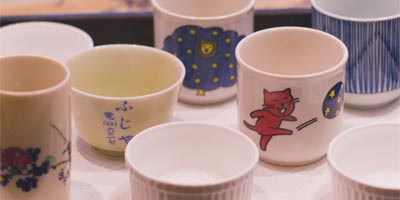 (I didn’t have molds that were all the same, so I used my collection of Japanese tea cups instead! – The two illustrated ones are from my childhood. And the one with the writing is a soba (buckwheat noodle) sauce dish that my parents brought over from Japan over 25 years ago!)
(I didn’t have molds that were all the same, so I used my collection of Japanese tea cups instead! – The two illustrated ones are from my childhood. And the one with the writing is a soba (buckwheat noodle) sauce dish that my parents brought over from Japan over 25 years ago!)
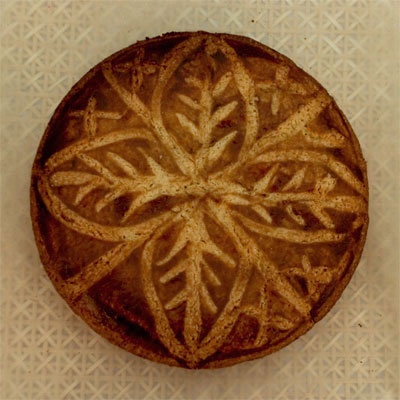 (Picture taken at the stall table. РThe patterned background?? I recently started to use woven wooden placemats bought from Ikea & baking paper on top to display my cakes, instead of cake cooling racks!)
(Picture taken at the stall table. РThe patterned background?? I recently started to use woven wooden placemats bought from Ikea & baking paper on top to display my cakes, instead of cake cooling racks!)